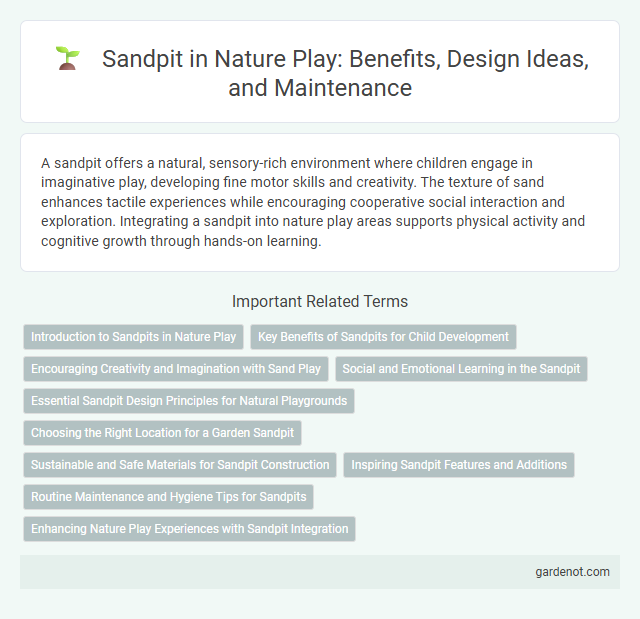A sandpit offers a natural, sensory-rich environment where children engage in imaginative play, developing fine motor skills and creativity. The texture of sand enhances tactile experiences while encouraging cooperative social interaction and exploration. Integrating a sandpit into nature play areas supports physical activity and cognitive growth through hands-on learning.
Introduction to Sandpits in Nature Play
Sandpits in nature play provide children with tactile and sensory experiences that promote creativity and fine motor skills. Natural materials like sand encourage open-ended exploration and social interaction in outdoor environments. Incorporating sandpits into play areas supports cognitive development through hands-on learning and imaginative play.
Key Benefits of Sandpits for Child Development
Sandpits enhance fine motor skills by encouraging children to dig, scoop, and mold sand, which strengthens hand-eye coordination and dexterity. They promote sensory development through tactile exploration, helping children understand different textures and consistencies. Social skills and creativity flourish as children engage in cooperative play, imaginative scenarios, and problem-solving activities within the sandpit environment.
Encouraging Creativity and Imagination with Sand Play
Sandpits provide an open-ended environment that stimulates children's creativity and imagination through tactile exploration and sensory play. Children experiment with building shapes, textures, and structures, enhancing problem-solving skills and spatial awareness. Engaging with sand encourages storytelling and role-playing, making it a powerful tool for cognitive and social development in outdoor learning settings.
Social and Emotional Learning in the Sandpit
The sandpit fosters social and emotional learning by encouraging cooperative play, communication, and conflict resolution among children. Engaging in shared sand activities helps develop empathy, patience, and teamwork as children negotiate roles and share resources. This interactive environment supports emotional regulation and strengthens friendships through creative collaboration.
Essential Sandpit Design Principles for Natural Playgrounds
Essential sandpit design principles for natural playgrounds emphasize using non-toxic, fine-grained sand to ensure safety and sensory stimulation. Incorporating varied depths and natural materials like wood borders encourages creative play and supports motor skill development. Positioning the sandpit in a shaded area with proper drainage prevents overheating and water accumulation, maintaining cleanliness and comfort.
Choosing the Right Location for a Garden Sandpit
Selecting the ideal location for a garden sandpit involves ensuring it receives ample sunlight throughout the day to keep the sand dry and inviting for play. Positioning the sandpit away from trees prevents leaves and debris from contaminating the sand, while also reducing the risk of insect infestations. Accessibility and visibility from the house or play area enhance supervision, promoting a safe and enjoyable outdoor experience for children.
Sustainable and Safe Materials for Sandpit Construction
Using sustainable and safe materials for sandpit construction ensures long-lasting play spaces while minimizing environmental impact. Natural timber treated with non-toxic preservatives, recycled plastic lumber, and untreated hardwoods provide durable and eco-friendly options that resist weathering and harmful chemicals. Incorporating organic, chemical-free sand enhances child safety by reducing exposure to allergens and toxins commonly found in synthetic alternatives.
Inspiring Sandpit Features and Additions
Inspiring sandpit features include natural materials like smooth river stones and wooden edging that blend seamlessly into outdoor environments, enhancing sensory play and creativity. Adding elements such as hidden treasures, miniature tools, and water channels cultivates imaginative exploration while improving fine motor skills. Incorporating shade structures and seating encourages longer, comfortable play sessions, making the sandpit a dynamic, engaging space for children.
Routine Maintenance and Hygiene Tips for Sandpits
Regularly sifting sand in sandpits removes debris and prevents compaction, ensuring a clean play environment. Covering sandpits when not in use protects them from animals and contaminants, maintaining hygiene standards. Periodic sand replacement every 6 to 12 months minimizes bacterial buildup and enhances safety for children.
Enhancing Nature Play Experiences with Sandpit Integration
Integrating a sandpit into nature play areas enriches sensory exploration and fine motor skill development for children. Sandpits encourage creativity and cooperative play through tactile engagement with natural materials, supporting cognitive growth and social interaction. Strategic placement of sandpits near other natural elements like plants and water features amplifies immersive learning experiences and environmental awareness.
Sandpit Infographic

 gardenot.com
gardenot.com